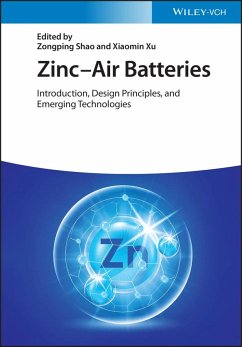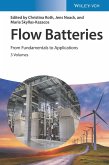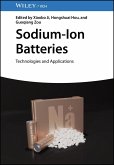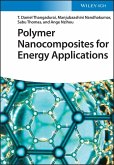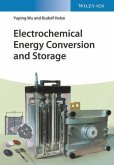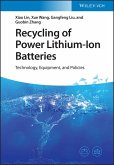Zinc-Air Batteries
Introduction, Design Principles and Emerging Technologies
Herausgegeben:Shao, Zongping; Xu, Xiaomin
Zinc-Air Batteries
Introduction, Design Principles and Emerging Technologies
Herausgegeben:Shao, Zongping; Xu, Xiaomin
- Gebundenes Buch
- Merkliste
- Auf die Merkliste
- Bewerten Bewerten
- Teilen
- Produkt teilen
- Produkterinnerung
- Produkterinnerung
This book covers every aspect of the Zn-air battery, ranging from its historical development to the design of its components and devices and to the new trends of research.
Andere Kunden interessierten sich auch für
![Rechargeable Organic Batteries Rechargeable Organic Batteries]() Yongzhu FuRechargeable Organic Batteries97,99 €
Yongzhu FuRechargeable Organic Batteries97,99 €![Flow Batteries, 3 Volume Set Flow Batteries, 3 Volume Set]() Flow Batteries, 3 Volume Set293,99 €
Flow Batteries, 3 Volume Set293,99 €![Sodium-Ion Batteries Sodium-Ion Batteries]() Sodium-Ion Batteries90,99 €
Sodium-Ion Batteries90,99 €![Polymer Nanocomposites for Energy Applications Polymer Nanocomposites for Energy Applications]() T. Daniel ThangaduraiPolymer Nanocomposites for Energy Applications139,00 €
T. Daniel ThangaduraiPolymer Nanocomposites for Energy Applications139,00 €![Electrochemical Energy Conversion and Storage Electrochemical Energy Conversion and Storage]() Yuping WuElectrochemical Energy Conversion and Storage60,99 €
Yuping WuElectrochemical Energy Conversion and Storage60,99 €![Recycling of Power Lithium-Ion Batteries Recycling of Power Lithium-Ion Batteries]() Xiao LinRecycling of Power Lithium-Ion Batteries125,00 €
Xiao LinRecycling of Power Lithium-Ion Batteries125,00 €![Alkaline Anion Exchange Membranes for Fuel Cells Alkaline Anion Exchange Membranes for Fuel Cells]() Alkaline Anion Exchange Membranes for Fuel Cells112,99 €
Alkaline Anion Exchange Membranes for Fuel Cells112,99 €-
-
-
This book covers every aspect of the Zn-air battery, ranging from its historical development to the design of its components and devices and to the new trends of research.
Hinweis: Dieser Artikel kann nur an eine deutsche Lieferadresse ausgeliefert werden.
Hinweis: Dieser Artikel kann nur an eine deutsche Lieferadresse ausgeliefert werden.
Produktdetails
- Produktdetails
- Verlag: Wiley-VCH
- Artikelnr. des Verlages: 1135046 000
- 1. Auflage
- Seitenzahl: 304
- Erscheinungstermin: 16. November 2022
- Englisch
- Abmessung: 250mm x 175mm x 20mm
- Gewicht: 696g
- ISBN-13: 9783527350469
- ISBN-10: 3527350462
- Artikelnr.: 63959352
- Herstellerkennzeichnung
- Wiley-VCH GmbH
- Boschstraße 12
- 69469 Weinheim
- wiley.buha@zeitfracht.de
- Verlag: Wiley-VCH
- Artikelnr. des Verlages: 1135046 000
- 1. Auflage
- Seitenzahl: 304
- Erscheinungstermin: 16. November 2022
- Englisch
- Abmessung: 250mm x 175mm x 20mm
- Gewicht: 696g
- ISBN-13: 9783527350469
- ISBN-10: 3527350462
- Artikelnr.: 63959352
- Herstellerkennzeichnung
- Wiley-VCH GmbH
- Boschstraße 12
- 69469 Weinheim
- wiley.buha@zeitfracht.de
Zongping Shao is currently a John Curtin Distinguished Professor at Curtin University, Australia. He obtained his Ph.D. degree from Dalian Institute of Chemical Physics, China, in 2000. Xiaomin Xu is currently a Research Associate at Curtin University, Australia. He received his Ph.D. degree in Chemical Engineering from Curtin University in 2021.
1 INTRODUCTION TO ZINC-AIR BATTERIES
1.1 Introduction
1.2 History of Zn-air battery
1.3 Structure and principle of Zn-air battery
1.4 Evaluation of Zn-air battery
1.5 Main issues of Zn-air battery
2 DESIGN OF OXYGEN REDUCTION CATALYSTS IN PRIMARY ZINC-AIR BATTERIES
2.1 Overview of oxygen reduction catalysts
2.2 Precious metal catalysts
2.3 Single-atom catalysts
2.4 Carbon-based catalysts
2.5 Transition metal oxide catalysts
2.6 Miscellaneous catalysts
3 DESIGN OF BIFUNCTIONAL OXYGEN CATALYSTS IN RECHARGEABLE ZINC-AIR BATTERIES
3.1 Oxygen redox reactions and catalyst candidates
3.2 Carbon
3.3 Metal oxides
3.4 Heterostructured catalysts
3.5 Carbon-based composites
3.6 Other emerging catalysts
3.7 Binder-free catalysts
4 DESIGN OF THREE-DIMENSIONAL AIR CATHODE IN ZINC-AIR BATTERIES
4.1 Overview of three-dimensional air cathode
4.2 Load of carbon-based catalysts
4.3 Load of transition metal compounds
4.4 Design of three-phase interface
4.5 Conclusions
5 DESIGN OF ZN ANODE FOR ZINC-AIR BATTERIES
5.1 Introduction
5.2 Methods to optimize Zn anode for Zn-air batteries
5.3 Conclusion and perspectives
6 DESIGN of ELECTROLYTE FOR ZINC-AIR BATTERIES
6.1 Liquid electrolytes
6.2 Gel polymer electrolyte
7 NEW DESIGN of ZINC-AIR BATTERIES
7.1 Flexible Zn-air battery
7.2 Hybrid Zn-air battery
7.3 Zn-air flow battery
8 INDUSTRIAL DEVELOPMENTS OF ZN-AIR BATTERIES
8.1 History of Zn-air batteries
8.2 Primary Zn-air batteries
8.3 Rechargeable Zn-air batteries
1.1 Introduction
1.2 History of Zn-air battery
1.3 Structure and principle of Zn-air battery
1.4 Evaluation of Zn-air battery
1.5 Main issues of Zn-air battery
2 DESIGN OF OXYGEN REDUCTION CATALYSTS IN PRIMARY ZINC-AIR BATTERIES
2.1 Overview of oxygen reduction catalysts
2.2 Precious metal catalysts
2.3 Single-atom catalysts
2.4 Carbon-based catalysts
2.5 Transition metal oxide catalysts
2.6 Miscellaneous catalysts
3 DESIGN OF BIFUNCTIONAL OXYGEN CATALYSTS IN RECHARGEABLE ZINC-AIR BATTERIES
3.1 Oxygen redox reactions and catalyst candidates
3.2 Carbon
3.3 Metal oxides
3.4 Heterostructured catalysts
3.5 Carbon-based composites
3.6 Other emerging catalysts
3.7 Binder-free catalysts
4 DESIGN OF THREE-DIMENSIONAL AIR CATHODE IN ZINC-AIR BATTERIES
4.1 Overview of three-dimensional air cathode
4.2 Load of carbon-based catalysts
4.3 Load of transition metal compounds
4.4 Design of three-phase interface
4.5 Conclusions
5 DESIGN OF ZN ANODE FOR ZINC-AIR BATTERIES
5.1 Introduction
5.2 Methods to optimize Zn anode for Zn-air batteries
5.3 Conclusion and perspectives
6 DESIGN of ELECTROLYTE FOR ZINC-AIR BATTERIES
6.1 Liquid electrolytes
6.2 Gel polymer electrolyte
7 NEW DESIGN of ZINC-AIR BATTERIES
7.1 Flexible Zn-air battery
7.2 Hybrid Zn-air battery
7.3 Zn-air flow battery
8 INDUSTRIAL DEVELOPMENTS OF ZN-AIR BATTERIES
8.1 History of Zn-air batteries
8.2 Primary Zn-air batteries
8.3 Rechargeable Zn-air batteries
1 INTRODUCTION TO ZINC-AIR BATTERIES
1.1 Introduction
1.2 History of Zn-air battery
1.3 Structure and principle of Zn-air battery
1.4 Evaluation of Zn-air battery
1.5 Main issues of Zn-air battery
2 DESIGN OF OXYGEN REDUCTION CATALYSTS IN PRIMARY ZINC-AIR BATTERIES
2.1 Overview of oxygen reduction catalysts
2.2 Precious metal catalysts
2.3 Single-atom catalysts
2.4 Carbon-based catalysts
2.5 Transition metal oxide catalysts
2.6 Miscellaneous catalysts
3 DESIGN OF BIFUNCTIONAL OXYGEN CATALYSTS IN RECHARGEABLE ZINC-AIR BATTERIES
3.1 Oxygen redox reactions and catalyst candidates
3.2 Carbon
3.3 Metal oxides
3.4 Heterostructured catalysts
3.5 Carbon-based composites
3.6 Other emerging catalysts
3.7 Binder-free catalysts
4 DESIGN OF THREE-DIMENSIONAL AIR CATHODE IN ZINC-AIR BATTERIES
4.1 Overview of three-dimensional air cathode
4.2 Load of carbon-based catalysts
4.3 Load of transition metal compounds
4.4 Design of three-phase interface
4.5 Conclusions
5 DESIGN OF ZN ANODE FOR ZINC-AIR BATTERIES
5.1 Introduction
5.2 Methods to optimize Zn anode for Zn-air batteries
5.3 Conclusion and perspectives
6 DESIGN of ELECTROLYTE FOR ZINC-AIR BATTERIES
6.1 Liquid electrolytes
6.2 Gel polymer electrolyte
7 NEW DESIGN of ZINC-AIR BATTERIES
7.1 Flexible Zn-air battery
7.2 Hybrid Zn-air battery
7.3 Zn-air flow battery
8 INDUSTRIAL DEVELOPMENTS OF ZN-AIR BATTERIES
8.1 History of Zn-air batteries
8.2 Primary Zn-air batteries
8.3 Rechargeable Zn-air batteries
1.1 Introduction
1.2 History of Zn-air battery
1.3 Structure and principle of Zn-air battery
1.4 Evaluation of Zn-air battery
1.5 Main issues of Zn-air battery
2 DESIGN OF OXYGEN REDUCTION CATALYSTS IN PRIMARY ZINC-AIR BATTERIES
2.1 Overview of oxygen reduction catalysts
2.2 Precious metal catalysts
2.3 Single-atom catalysts
2.4 Carbon-based catalysts
2.5 Transition metal oxide catalysts
2.6 Miscellaneous catalysts
3 DESIGN OF BIFUNCTIONAL OXYGEN CATALYSTS IN RECHARGEABLE ZINC-AIR BATTERIES
3.1 Oxygen redox reactions and catalyst candidates
3.2 Carbon
3.3 Metal oxides
3.4 Heterostructured catalysts
3.5 Carbon-based composites
3.6 Other emerging catalysts
3.7 Binder-free catalysts
4 DESIGN OF THREE-DIMENSIONAL AIR CATHODE IN ZINC-AIR BATTERIES
4.1 Overview of three-dimensional air cathode
4.2 Load of carbon-based catalysts
4.3 Load of transition metal compounds
4.4 Design of three-phase interface
4.5 Conclusions
5 DESIGN OF ZN ANODE FOR ZINC-AIR BATTERIES
5.1 Introduction
5.2 Methods to optimize Zn anode for Zn-air batteries
5.3 Conclusion and perspectives
6 DESIGN of ELECTROLYTE FOR ZINC-AIR BATTERIES
6.1 Liquid electrolytes
6.2 Gel polymer electrolyte
7 NEW DESIGN of ZINC-AIR BATTERIES
7.1 Flexible Zn-air battery
7.2 Hybrid Zn-air battery
7.3 Zn-air flow battery
8 INDUSTRIAL DEVELOPMENTS OF ZN-AIR BATTERIES
8.1 History of Zn-air batteries
8.2 Primary Zn-air batteries
8.3 Rechargeable Zn-air batteries

